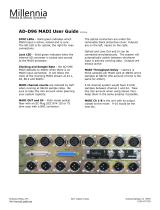
3
• Read these Instructions • Keep these instructions
• Heed all warnings • Follow all instructions
1. Do not use this device near water.
2. Clean only with a dry cloth. Do not spray liquid cleaner onto the faceplate or into the
ventilation slots. This may damage the front panel or cause a dangerous condition.
3. Only install in accordance with the manufacturer’s instructions.
4. Do not install or operate near heat sources such as stoves, radiators or other devices
that may produce heat.
5. NEVER compromise the functioning of the power plug’s ground connection. When
the provided plug doesn’t fit into the outlet, please consult a qualified electrician for
assistance.
6. Use power adaptors and accessories specified by the manufacturer only.
7. Protect the power cord from being pinched or stepped on.
8. Unplug this device during lightning storms, or when not in use for extended periods of time.
9. Refer all servicing to qualified service personnel only. Servicing is required when the
device has been damaged in any way. For example when liquids have been spilled on
the device, objects have fallen onto it, or the device itself has been dropped. Servicing
is also essential when the device no longer functions normally or has been exposed
to rain or moisture.
10. This unit generates heat during normal operation. Use it in a well ventilated environ-
ment with at least 1RU space between any other equipment.
11. This product in combination with headphones or other external amplifiers and
speakers may produce sound levels that could lead to permanent hearing damage.
Do not operate at high or uncomfortable volume levels for a long time. If you are
experiencing ringing in your ears, a loss of high frequency sound information or
other hearing loss, please contact an audiologist immediately.
12. WARNING: To reduce the risk of an electric shock or fire, do not expose the device
to rain or moisture.
13. The power supply of this audio device may cause electronic interference to surround-
ing equipment. If you find that this or any nearby unit is malfunctioning, try resetting
the device, relocating it, or getting an electrician to install a powerline conditioner.
14. Always use a stand, 19“ rack or table designed for the use of pro audio equipment.
In a permanent installation make sure that damage or even injury will not result from
the mounting of the device or from cables pulling on the device. When using a cart,
use caution when moving the device inside the cart to avoid injury from tipping-over.





















